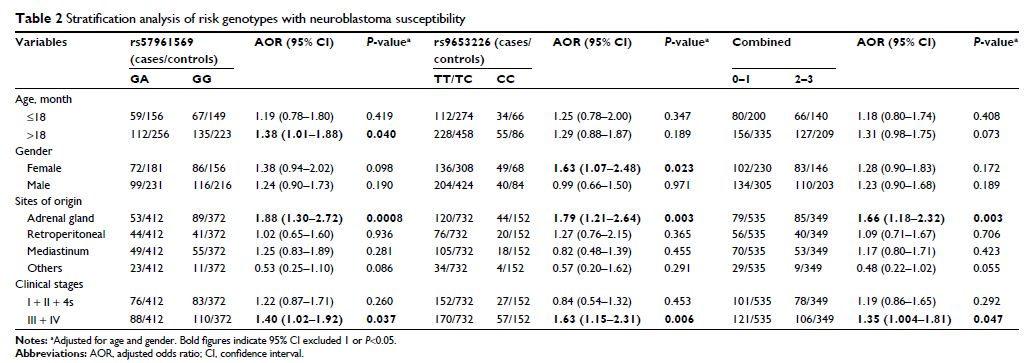108384
论文已发表
注册即可获取德孚的最新动态
IF 收录期刊
- 3.4 Breast Cancer (Dove Med Press)
- 3.2 Clin Epidemiol
- 2.6 Cancer Manag Res
- 2.9 Infect Drug Resist
- 3.7 Clin Interv Aging
- 5.1 Drug Des Dev Ther
- 3.1 Int J Chronic Obstr
- 6.6 Int J Nanomed
- 2.6 Int J Women's Health
- 2.9 Neuropsych Dis Treat
- 2.8 OncoTargets Ther
- 2.0 Patient Prefer Adher
- 2.2 Ther Clin Risk Manag
- 2.5 J Pain Res
- 3.0 Diabet Metab Synd Ob
- 3.2 Psychol Res Behav Ma
- 3.4 Nat Sci Sleep
- 1.8 Pharmgenomics Pers Med
- 2.0 Risk Manag Healthc Policy
- 4.1 J Inflamm Res
- 2.0 Int J Gen Med
- 3.4 J Hepatocell Carcinoma
- 3.0 J Asthma Allergy
- 2.2 Clin Cosmet Investig Dermatol
- 2.4 J Multidiscip Healthc

MYCN 基因多态性与中国儿童神经母细胞瘤风险:一项 3-中心病例对照研究
Authors Zhou H, Zhuo Z, Chen S, Zhao J, Mo Y, Zhang J, He J, Ruan J
Received 17 March 2018
Accepted for publication 28 April 2018
Published 2 July 2018 Volume 2018:10 Pages 1807—1816
DOI https://doi.org/10.2147/CMAR.S168515
Checked for plagiarism Yes
Review by Single-blind
Peer reviewers approved by Dr Amy Norman
Peer reviewer comments 2
Editor who approved publication: Professor Nakshatri
Introduction: Neuroblastoma is an embryonal tumor of the sympathetic nervous
system. The MYCN oncogene is amplified in some
neuroblastoma patients and correlated with poor prognosis. However, less is
known regarding the relationship between MYCN gene
single-nucleotide polymorphisms (SNPs) and neuroblastoma risk.
Patients and
methods: To investigate the
contribution of MYCN gene
polymorphisms to neuroblastoma risk, we performed a 3-center case–control study
by genotyping 4 SNPs in the MYCN gene from
429 cases and 884 controls.
Results: The results showed that only rs57961569 G>A was associated with
neuroblastoma risk (GA vs GG: adjusted odds ratio =0.76, 95% confidence
interval =0.60–0.98, P =0.033), while the
other 3 SNPs were not (rs9653226 T>C, rs13034994 A>G, and rs60226897
G>A). Stratified analysis revealed that rs57961569 GG carriers were more
likely to develop neuroblastoma in the following subgroups: children older than
18 months, tumor derived from the adrenal gland, and clinical stages III + IV.
The increased neuroblastoma risk associated with the rs9653226 variant CC
genotypes was more evident in the following subgroups: females, tumor derived
from the adrenal gland, and clinical stages III + IV. The presence of 2–3 risk
genotypes had a significant relationship with the following subgroups: tumor derived
from the adrenal gland and clinical stages III + IV.
Conclusion: This study demonstrates a weak impact of MYCN gene polymorphisms on
neuroblastoma risk, which should be further validated.
Keywords: neuroblastoma, susceptibility, MYCN ,
polymorphism
